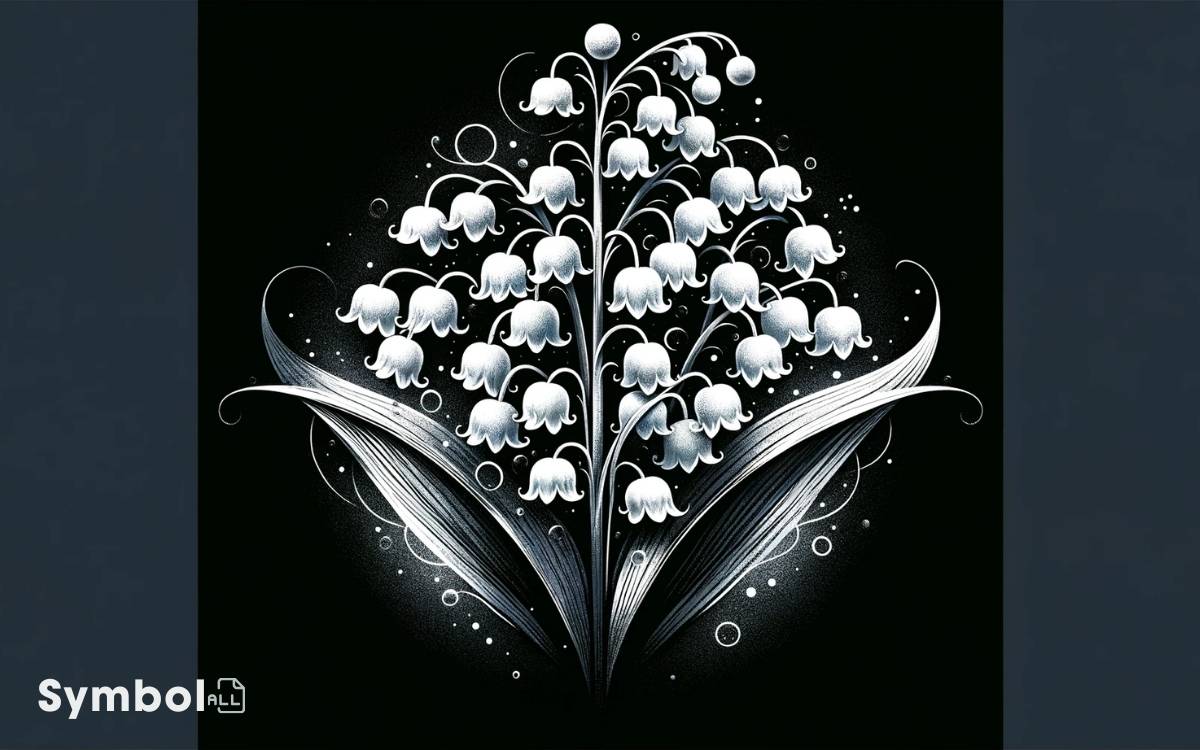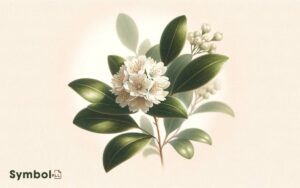Lily of the Valley Flower Symbolism: Purity, Happiness!
You’ve discovered the Lily of the Valley, a plant originating from temperate Europe and Asia, thriving under dappled sunlight with rhizomatic propagation.
Cultivated for its alluring fragrance and aesthetic, it symbolizes purity and the return of happiness. This plant’s association with resilience, renewal, and its role in Christian and royal symbols highlight its significance.
Cultivation demands attention to soil acidity, moisture, and light, enhancing its fragrant, bell-shaped flowers.
Embraced globally, its presence in gardens marks renewal and a shift towards warmer seasons. Unraveling its complexities reveals deeper insights into its cultural and medicinal value.

Key Takeaways
Historical Origins
Tracing its roots back to the temperate regions of Europe and Asia, the Lily of the Valley has been cultivated for centuries due to its enchanting fragrance and delicate appearance.
You’ll find its propagation is primarily through rhizomes, underpinning a cultivation process that demands precise conditions moist, well-drained soil and partial shade.
These perennial plants exhibit a robust adaptability in temperate climates, thriving under deciduous trees that provide the dappled sunlight necessary for best growth.
Its cultivation, deeply embedded in horticultural practices, showcases a blend of aesthetic appeal and scientific precision.
The plant’s ability to spread and naturalize under suitable conditions has made it a staple in traditional and contemporary gardens alike, embodying a rich horticultural heritage that continues to captivate and inspire gardeners around the globe.
Symbol of Purity
Throughout its cultivation history, the Lily of the Valley has been revered as a symbol of purity, reflecting its pristine white blossoms and the meticulous care required for its propagation.
This perennial plant, scientifically known as Convallaria majalis, thrives in well-drained, slightly acidic soils, under partial shade, embodying the virtue of purity not only in its appearance but also in its demanding growth conditions.
The plant’s delicate, bell-shaped flowers exude a fragrant scent, further accentuating its association with cleanliness and innocence.
Cultivators often employ precise soil amendments and careful irrigation practices to maintain the ideal environment for its growth, underscoring the plant’s status as a botanical emblem of purity.
This rigorous cultivation process ensures the preservation of its symbolic and aesthetic qualities, making it a cherished specimen in gardens dedicated to purity and serenity.
Religious Significance
Beyond its purity, the Lily of the Valley holds deep religious significance, symbolizing the return of happiness as mentioned in Christian lore and texts.
In botanical terms, Convallaria majalis, as it’s scientifically known, thrives in temperate woodlands, embodying an intricate symbiosis that mirrors spiritual interconnectedness.
Its perennial nature and preference for shaded, well-drained soils reflect resilience and renewal themes prevalent in religious narratives.
Cultivation practices highlight its propagation through rhizomes, underscoring themes of growth and rebirth. This flower’s delicate appearance belies its robust nature, serving as a metaphor for spiritual endurance.
Its springtime blooming aligns with Easter, reinforcing resurrection symbolism. Consequently, the Lily of the Valley’s biological characteristics and cultivation intricacies deeply intertwine with its religious symbolism, offering a rich tapestry of meaning for those seeking spiritual insight.
Myths and Legends
Delving into myths and legends, you’ll find the Lily of the Valley woven into tales that often highlight its mystical properties and symbolic meanings in various cultures.
Here are a few notable aspects:
- Propagation Myths: Ancient narratives suggest that the Lily of the Valley’s ability to propagate through rhizomes symbolizes immortality and the spread of spiritual enlightenment.
- Bloom Timing Legends: Its springtime bloom is often linked to tales of renewal and purity, marking significant shifts in the natural world.
- Toxicity Folklore: The plant’s toxic properties led to associations with protection against evil spirits in folklore, emphasizing its dual nature of beauty and danger.
- Cultivation Tales: Myths surrounding its cultivation often speak to human attempts to harness its symbolic virtues, illustrating a deep respect for the natural order and the complexities of botanical life.
Royal Associations
Shifting our focus from folklore to historical accounts, the Lily of the Valley holds esteemed significance in royal emblems and ceremonies, symbolizing purity and the return of happiness.
This perennial plant, scientifically termed Convallaria majalis, thrives in temperate woodlands, deploying a sophisticated mechanism of vegetative propagation.
Its presence in royal gardens isn’t merely ornamental; the cultivation practices reflect a meticulous attention to soil pH, moisture levels, and shade requirements, ensuring best growth and bloom.
Historically, royals have employed its delicate, bell-shaped flowers in coronation garlands and wedding bouquets, underscoring its emblematic value of renewal and ceremonial purity.
These practices illuminate a deep-seated reverence for botanical symbolism in royal traditions, where the Lily of the Valley transcends mere aesthetics, embodying historical continuity and the cultivation of virtues.
Connection to Happiness
The Lily of the Valley’s enchanting fragrance, scientifically linked to mood enhancement, illustrates its profound connection to happiness.
This alluring plant harbors several attributes that elevate the spirits:
- Phenylethylamine Production: Responsible for the euphoric feeling often associated with love, this chemical compound is found in the flowers, contributing to emotional upliftment.
- Convallarin: An active compound in the plant, which, through olfactory stimulation, can help reduce stress levels.
- Optimal Growing Conditions: Thriving in partially shaded areas with well-drained soil, its successful cultivation brings a sense of achievement and joy to horticulturists.
- Visual Appeal: The delicate, bell-shaped flowers and vibrant green leaves have an aesthetically pleasing appearance that can brighten any environment, fostering a happier mood.
May Day Tradition
In many cultures, Lily of the Valley plays a central role in May Day celebrations, symbolizing the return of happiness and the renewal of spring.
This perennial plant, scientifically known as Convallaria majalis, thrives in temperate woodlands and requires specific cultivation conditions, including well-drained soil rich in organic matter and partial shade.
Its propagation, primarily through rhizome division in autumn, guarantees robust growth by the following May.
The custom of gathering these fragrant, bell-shaped flowers on the first day of May and presenting them to loved ones or integrating them into festive garlands and bouquets reflects an appreciation for their delicate beauty and the ephemeral nature of spring.
The act embodies a gesture of goodwill, enhancing social bonds and fostering communal spirit amidst the floral bounty.
In Literature and Art
Lily of the Valley’s delicate appearance and complex fragrance have captivated artists and writers, inspiring its frequent representation in their works.
Its portrayal often embodies purity, humility, and the return of happiness, weaving a rich tapestry of symbolism within literature and visual art.
You’ll find this flower symbolizing:
- Renewal and Hope: Artists depict its perennial nature as a metaphor for rebirth.
- Fragility and Innocence: In paintings, its slender stems and bell-shaped flowers emphasize subtle beauty and purity.
- Mortality: Writers use it to remind readers of life’s fleeting nature, given its brief blooming period.
- Scientific Intrigue: Detailed botanical illustrations reflect a fascination with its toxicology and medicinal properties, highlighting the plant’s dual nature of danger and allure.
Understanding its complex symbolism enriches your appreciation of its presence in cultural works.
Wedding Flower Traditions
Amid wedding traditions, you’ll often find Lily of the Valley playing an important role due to its symbolic representation of purity and happiness, making it a sought-after choice for bridal bouquets and decorations.
Cultivated meticulously, Convallaria majalis requires specific conditions partial shade, well-drained, slightly acidic soil to thrive and produce its delicate, bell-shaped flowers.
Its propagation, through rhizome division or pips, demands expertise, ensuring a robust bloom for the wedding season.
The plant’s resilience, once established, mirrors the enduring nature of marital bliss, adding a layer of metaphorical significance.
Careful handling is paramount, as all parts of the plant are toxic, necessitating knowledgeable florists to incorporate them safely into wedding arrangements.
This intricate cultivation process culminates in the emblematic presence of these flowers, symbolizing the beginning of a pure and joyous union.
Medicinal Uses
Historically, Convallaria majalis has been utilized in traditional medicine to explore specific heart conditions, thanks to its cardiac glycosides. These active compounds have been carefully extracted and studied for their potent effects on the human heart.
As you investigate the medicinal uses of this plant, you’ll find its application extends beyond heart ailments:
- Diuretic properties: Enhances renal function, promoting fluid excretion.
- Sedative effects: Utilized in managing stress and inducing calmness.
- Vasodilation capabilities: Aids in reducing blood pressure by dilating blood vessels.
- Anti-congestive qualities: Helps in alleviating symptoms of congestive heart failure.
Understanding these applications requires a deep appreciation for the precise cultivation and extraction processes, ensuring the therapeutic potential of Convallaria majalis is harnessed responsibly and effectively.
Varieties and Characteristics
Convallaria majalis boasts a diverse range of varieties, each characterized by unique features such as flower shape, scent intensity, and leaf variegation, essential for successful cultivation.
You’ll find that the ‘Fortin’s Giant’ variety offers larger blooms and more robust growth, making it a popular choice for those seeking visual impact. Conversely, ‘Albostriata‘ is noted for its striking, white-striped foliage, adding a variegated texture to garden settings.
Each variety also differs in scent intensity, a pivotal aspect for enthusiasts aiming to create a fragrant garden atmosphere. Understanding these characteristics is vital in selecting the right cultivar to meet specific aesthetic and olfactory goals.
It’s the combination of these traits that dictates their ideal placement and companion planting within garden designs.
Cultivation and Care
To guarantee your Lily of the Valley thrives, you must comprehend its specific cultural requirements. They require well-drained, slightly acidic soil and flourish under partial shade, though they tolerate a range of light conditions.
Sufficient watering, especially during dry spells, is vital to sustain their delicate blooms and lush foliage.
Ideal Soil Conditions
Guaranteeing optimal growth for Lily of the Valley involves providing well-drained soil rich in organic matter, with a slightly acidic to neutral pH.
To create the ideal conditions, focus on:
- Soil Composition: Include organic compost to improve fertility. This enhances soil structure, facilitating better root penetration and water retention.
- pH Levels: Target a pH range of 6.0 to 7.0. Utilize a soil pH tester to determine your soil’s current status and adjust accordingly using sulfur or lime.
- Drainage: Ensure the planting site doesn’t retain water. Modify heavy clay soils with sand or grit to enhance drainage.
- Nutrient Management: Apply a balanced, slow-release fertilizer annually to support strong growth without overwhelming the plant.
Understanding these soil requirements will greatly impact your Lily of the Valley’s health and flowering capability.
Watering and Light Needs
After establishing the ideal soil conditions, it’s vital to address the watering and light requirements to foster robust Lily of the Valley growth. These plants thrive in moist, well-drained environments, necessitating consistent hydration without waterlogging.
You’ll aim for a balance, ensuring the soil remains damp but not saturated. Overwatering can lead to root rot, a condition detrimental to the plant’s health.
Regarding light, Lily of the Valley prefers dappled sunlight, mirroring its natural understory habitat. Direct sunlight can scorch its leaves, while too much shade diminishes flowering.
Opt for a location that receives morning light and afternoon shade, or use a canopy of taller plants to filter sunlight. This precise light balance encourages ideal photosynthesis and bloom production, essential for the plant’s vigor.
Global Celebrations
Why do people across the globe celebrate with the delicate Lily of the Valley, you might wonder? This plant, scientifically known as Convallaria majalis, plays a significant role in various global celebrations due to its unique characteristics and cultivation requirements.
Here are four key reasons:
- Phenological Significance: Its blooming period marks the shift from spring to summer in many cultures, symbolizing renewal.
- Cultivation Practices: The meticulous care required for its growth reflects dedication, making it a prized gift.
- Biological Rarity: Its limited flowering window adds exclusivity to events.
- Aesthetic Appeal: The pure white, bell-shaped flowers and sweet fragrance enhance ceremonial decor.
Understanding these factors reveals why *Convallaria majalis* holds a cherished place in global festivities, beyond mere tradition.
Contemporary Meanings
In modern contexts, the Lily of the Valley embodies diverse meanings, ranging from purity and renewal to the more intricate symbolism tied to its cultivation and biological characteristics.
You’ll find its propagation fascinating; it spreads primarily through rhizomes under the soil, a process mirroring resilience and interconnected growth.
This characteristic illustrates not just survival, but thriving through unity and connectivity, echoing themes of community and mutual support.
Its preference for shady, moist environments speaks to adaptability and finding strength in what may seem like unfavorable conditions. The plant’s delicate appearance belies its toxic nature, a reminder of the complexities beneath surface impressions.
Understanding its growth requirements rich, well-drained soil, partial shade parallels recognizing the need for nurturing environments to flourish, emphasizing the importance of care and attention in cultivation and personal development.
Conservation Efforts
Given its ecological importance and vulnerability, conservation efforts for the Lily of the Valley are essential in maintaining its habitat and ensuring its propagation.
To engage effectively in these efforts, you must consider the following strategies:
- Implementing Ex Situ Conservation: Cultivating the plants in controlled environments to safeguard genetic diversity.
- Restoring Natural Habitats: Rehabilitating disturbed areas to provide suitable growth conditions.
- Controlling Invasive Species: Managing or eradicating invasive flora that competes for resources.
- Raising Public Awareness: Educating communities about the plant’s significance and conservation methods.
These actions are pivotal in fostering a sustainable environment for the Lily of the Valley. By adopting a meticulous approach towards conservation, you contribute to preserving this species for future generations, ensuring its continued role in biodiversity and cultural heritage.
Conclusion
To sum up, you’ve delved into the multifaceted symbolism of the lily of the valley, from its historical roots to its contemporary meanings.
Its cultivation requires precise care, thriving in well-drained, slightly acidic soil under partial shade. For example, envision a dedicated gardener in Belgium meticulously nurturing these delicate blooms, symbolizing their own pursuit of purity and happiness.
This flower’s global celebrations and conservation efforts underscore its enduring appeal and significance. Embrace its lessons, nurturing your own garden of life with similar dedication and care.






